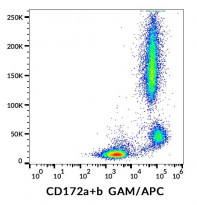ARG42433
anti-CD172a + CD172b antibody [SE5A5]
anti-CD172a + CD172b antibody [SE5A5] for Flow cytometry and Human
Overview
| Product Description | Mouse Monoclonal antibody [SE5A5] recognizes CD172a + CD172b |
|---|---|
| Tested Reactivity | Hu |
| Tested Application | FACS |
| Specificity | The mouse monoclonal antibody SE5A5 recognizes a common extracellular epitope on human CD172a and CD172b antigens (approx. 90 kDa and approx. 50 kDa, respectively), although its reactivity with CD172a is higher. |
| Host | Mouse |
| Clonality | Monoclonal |
| Clone | SE5A5 |
| Isotype | IgG1 |
| Target Name | CD172a + CD172b |
| Antigen Species | Human |
| Immunogen | NIH/3T3 cells transfected with Human CD172a. |
| Conjugation | Un-conjugated |
| Alternate Names | CD172A; p84; SHPS1; SHPS-1; CD172 antigen-like family member A; Sirp-alpha-3; Sirp-alpha-1; BIT; MYD-1; MFR; Bit; PTPNS1; CD antigen CD172a; Inhibitory receptor SHPS-1; SIRP; MyD-1 antigen; Sirp-alpha-2; Tyrosine-protein phosphatase non-receptor type substrate 1; Signal-regulatory protein alpha-1; Signal-regulatory protein alpha-2; Signal-regulatory protein alpha-3; Macrophage fusion receptor; Brain Ig-like molecule with tyrosine-based activation motifs; P84; SHP substrate 1 |
Application Instructions
| Application Suggestion |
|
||||
|---|---|---|---|---|---|
| Application Note | * The dilutions indicate recommended starting dilutions and the optimal dilutions or concentrations should be determined by the scientist. |
Properties
| Form | Liquid |
|---|---|
| Purification | Purification with Protein A. |
| Buffer | PBS and 15 mM Sodium azide. |
| Preservative | 15 mM Sodium azide |
| Concentration | 1 mg/ml |
| Storage Instruction | For continuous use, store undiluted antibody at 2-8°C for up to a week. For long-term storage, aliquot and store at -20°C or below. Storage in frost free freezers is not recommended. Avoid repeated freeze/thaw cycles. Suggest spin the vial prior to opening. The antibody solution should be gently mixed before use. |
| Note | For laboratory research only, not for drug, diagnostic or other use. |
Bioinformation
| Database Links |
Swiss-port # P78324 Human Tyrosine-protein phosphatase non-receptor type substrate 1 |
|---|---|
| Gene Symbol | SIRPA |
| Gene Full Name | signal-regulatory protein alpha |
| Background | The protein encoded by this gene is a member of the signal-regulatory-protein (SIRP) family, and also belongs to the immunoglobulin superfamily. SIRP family members are receptor-type transmembrane glycoproteins known to be involved in the negative regulation of receptor tyrosine kinase-coupled signaling processes. This protein can be phosphorylated by tyrosine kinases. The phospho-tyrosine residues of this PTP have been shown to recruit SH2 domain containing tyrosine phosphatases (PTP), and serve as substrates of PTPs. This protein was found to participate in signal transduction mediated by various growth factor receptors. CD47 has been demonstrated to be a ligand for this receptor protein. This gene and its product share very high similarity with several other members of the SIRP family. These related genes are located in close proximity to each other on chromosome 20p13. Multiple alternatively spliced transcript variants have been determined for this gene. [provided by RefSeq, Jul 2008] |
| Function | Immunoglobulin-like cell surface receptor for CD47. Acts as docking protein and induces translocation of PTPN6, PTPN11 and other binding partners from the cytosol to the plasma membrane. Supports adhesion of cerebellar neurons, neurite outgrowth and glial cell attachment. May play a key role in intracellular signaling during synaptogenesis and in synaptic function (By similarity). Involved in the negative regulation of receptor tyrosine kinase-coupled cellular responses induced by cell adhesion, growth factors or insulin. Mediates negative regulation of phagocytosis, mast cell activation and dendritic cell activation. CD47 binding prevents maturation of immature dendritic cells and inhibits cytokine production by mature dendritic cells. [UniProt] |
| Cellular Localization | Membrane; Single-pass type I membrane protein. [UniProt] |
| Calculated MW | 55 kDa |
| PTM | N-glycosylated. Phosphorylated on tyrosine residues in response to stimulation with EGF, growth hormone, insulin and PDGF. Dephosphorylated by PTPN11. [UniProt] |
Images (1) Click the Picture to Zoom In






